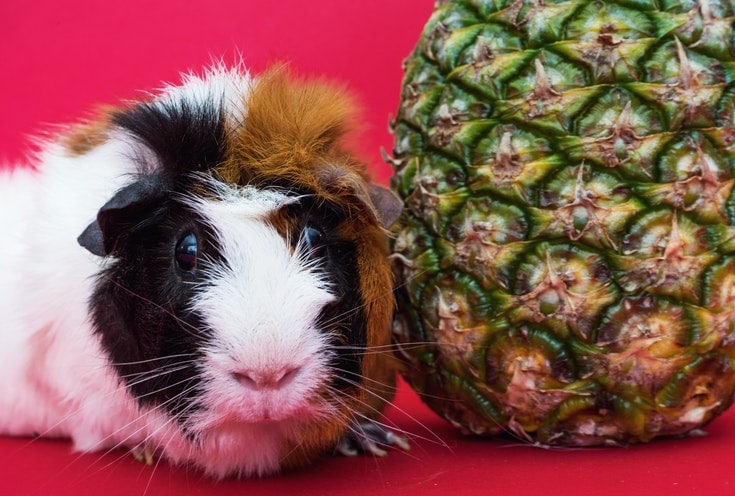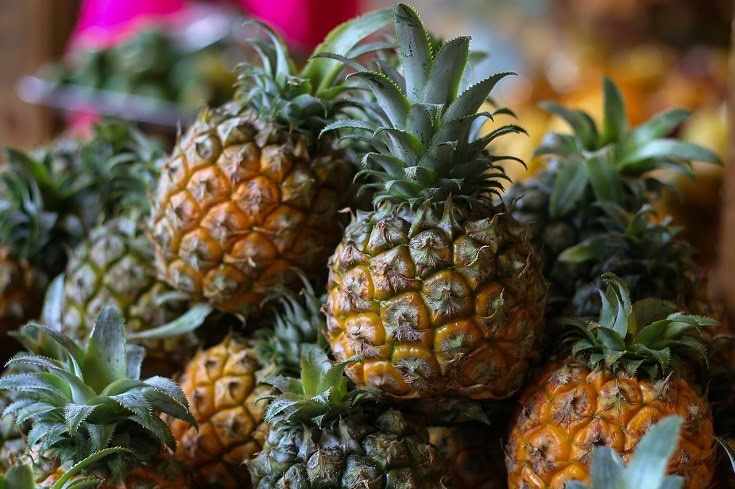VET APPROVED

The information is current and up-to-date in accordance with the latest veterinarian research.
Learn more »Pineapple, that delicious golden fruit most humans enjoy, has a combination of sweet, tart, and tangy that makes it irresistible to many. But how about sharing pineapple with our pets — guinea pigs specifically?
Good news! Guinea pigs can eat small amounts of pineapple. This fruit is relatively low in sugar, compared to other sweet treats, but still too sugary to be a significant feature in a guinea pig’s diet. So while it is fine to be fed in moderation as an occasional indulgence, it can cause major problems if fed too often or in too large a quantity. Feed once a week, ensure it is prepared properly, and never feed canned or juiced pineapple to your cavy.
Pineapple is equal parts sweet and bitter. It is juicy, refreshing, and has a unique taste. We eat it fresh, out of tins, and we put it in fruit salads, but how much is safe to feed our guinea pigs? How should it be prepared for them and how often should you give it to your little chunker? Are there any healthier alternatives? We find out below.

Benefits of Pineapples
Before we go through the details, we should keep in mind that pineapples are not found in a guinea pig’s natural habitat, and do not form part of their natural diet, so it is something that we can consider an occasional treat. Although you should avoid feeding too much pineapple to your guinea pig, in moderation it is not only considered safe but actually has a few benefits, including the following:
- Vitamin C – When you are thinking of the potential benefits of offering a treat to your guinea pig, you always want to consider Vitamin C. Like humans, guinea pigs cannot produce their own vitamin C, so they must obtain it from their diet. It can prevent scurvy, which is a relatively common problem in unhealthy cavies. Guinea pigs need 10-30 mg of vitamin C daily and they rely on dark leafy greens, vitamin C-rich veggies, and supplements for it. However, it’s good to consider that a serving size of 10 grams of pineapple can provide 0.48 mg of vitamin C.
- Manganese and Magnesium – Pineapple contains trace amounts of manganese and magnesium, minerals that are involved in enzyme function and muscle health, including heart muscle contraction. While the amount they can get in a treat size of pineapple is not enough to cover a guinea pig’s daily requirements, it’s good to know their treats are contributing a little to their health.
- Palatability and Hydration – We, as humans, are encouraged to eat fruit because it contains a host of vitamins and minerals and is low in fat. However the same benefits are not necessarily true for your guinea pig, and pineapple is considered to be a sweet treat for them. You do need to ensure that you only feed it in moderation, and that you take the appropriate steps to prepare it properly. But assuming that you do this, pineapple can make a great thirst quencher, a tasty little treat, that your guinea pig can enjoy on occasion.

Potential Dangers
So, pineapple is actually good for your guinea pig when fed in moderation, but the key to this is the term moderation. It should not become a staple part of your pet’s diet, and it should only be fed once a week at most. There are some potential dangers to feeding pineapple, but virtually all of these are associated with feeding too much of this sugary treat. These dangers include:
- Diarrhea – The human body is well equipped to digest the sugar in fruit, but the same isn’t necessarily true of your guinea pig. In fact, he will have a very hard time digesting the sugar content in pineapple if you feed him too much. Not only does this mean that he will likely put on weight if fed too often, but it can also lead to digestive complaints, including diarrhea and an upset stomach. Feed little and don’t feed it too often.
- Obesity – Like humans, guinea pigs are prone to obesity and they can also suffer from ailments like diabetes if they eat too many sugary foods. Because they are unable to properly digest the sugar content, this means that your guinea pig should limit the amount of fruit that he eats to prevent obesity.
- Acidity – Guinea pig’s delicate mouth and gastrointestinal tract can also be irritated by the low pH of pineapple. Its acidity can result in mouth sores known as cheilitis or stomatitis, or disrupt the gut microflora.

What About the Leaves and Core?
To ensure that your guinea pig enjoys the benefits of pineapple, without the concerns, you should feed in moderation, but you also need to ensure that you prepare the fruit properly before feeding.
Do not feed the leaves to your guinea pig. They have small, prickly thorns, which can get stuck in the throat and cause choking. Similarly, the skin of the pineapple is also a danger. Not only is it coarse, hard, and potentially packed full of the chemicals used in growing and the waxes used in storage, but they too have the same small thorns that can cause an obstruction or cause bleeding in the mouth and throat. The core of the pineapple, although not harmful or toxic, is very tough and your guinea pig is unlikely to be able to digest it properly which can cause impacted pain and other stomach complaints.
Preparing the Pineapple
When preparing the pineapple for your guinea pig, you need to first choose the right form of fruit. Absolutely avoid tinned fruit, because manufacturers use additives and other chemicals to help preserve the fruit and these can be potentially very harmful to your animal. Similarly, you should not feed pineapple juice to your guinea pig. Instead, choose a ripe pineapple, ideally organic, and then skin it, remove the core, and slice a tiny piece of soft pineapple flesh for your cavy.
Serving Size and Frequency
Pineapple really does need to be fed in moderation, to prevent your cavy from experiencing mouth irritation, digestive issues or gaining weight.
Once you have prepared the fruit, cut it into cubes. You can feed your guinea pig roughly 1 square inch (10-15 g) of the fruit every week, either in a single sitting or over 2 days. Always remove any uneaten vestiges of the fruit at the end of the day, because the pineapple can go bad and it will almost certainly attract flies and bugs.


Can Guinea Pigs Eat Pineapple? Final Thoughts
Pineapple divides human opinion. Some people love its combination of sweet and bitter, while others hate it. Similarly, your guinea pig might love its juiciness or they may not. In either case, know that a small amount of pineapple fed in moderation and as an occasional treat is not only safe, but can also offer a few benefits to your little guinea pig. It can provide a great way of supplementing a guinea pig’s staple hay diet with something a bit sweeter and more tantalizing. Do not feed the skin, leaves, or core, and never feed your guinea pig anything that is processed for human consumption such as tinned or juiced pineapple.
Looking to find out what else to feed your guinea? Check out these posts:










